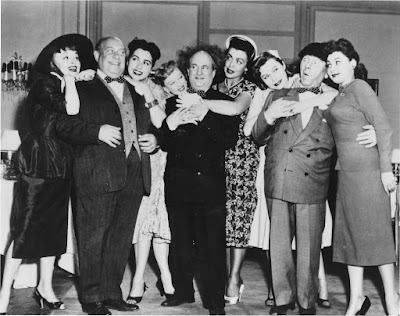It’s hot! It’s wet! No, it’s not a Blowfly song, it’s summer (more or less)! What do we do in the summer? We pile in the car and head down to the drive-in! Or we used to. I am one of the fortunate ones who is still able to partake in this particularly American pastime, as the Vali-Hi is literally just eight miles up the interstate from me! True, the only films available to see at the drive-in these days are first run features like three hour Marvel Comics pictures or computer animated children’s features, but sometimes it’s worth sitting through a Shrek or an Iron Man 3 just for the experience.
Not to step on the toes of the mighty Joe Bob Briggs, I thought, in celebration of the summer, I’d do an ode to the drive-in days of yore, much appreciated by Ichibunnies and nostalgia aficionados alike; back when there would be dusk-til-dawn show-o-ramas featuring quickie horror and sci-fi pictures. I’ve chosen a double feature of films that are easily accessible to watch from the comfort of your own home; free of the mosquitos, devoid of the hazard of the idiot in his monster-sized diesel guzzler pulling in to the front row spot ahead of you and blocking the screen, and no need to find D-cells for that old radio to tune in the audio.
Don’t worry, I’ll control myself and keep it brief.
Our first feature takes us out onto the Caribbean Sea and to the sunny beaches of South America. Watch out, there’s a commotion in the ocean, and it ain’t no giant clam! It’s Roger Corman’s 1961 heist/secret agent/comedy/monster picture Creature From The Haunted Sea! Describing the film won’t do it any favors, and showing a picture of the monster, if you aren’t familiar already, likely won’t entice you to watch it, but subjectively speaking I find it an enjoyable watch.
 |
Renzo and Mary-Belle smooch, unaware of the
creature waiting to strike. |
To boil it down, the political coup in Cuba that put Castro into power has run the old guard out. A general, Tostada, and a team of soldiers, make a deal with shady nightclub owner and gangster Renzo Capetto to smuggle the troops and a chunk of the Cuban treasury off of the island. Renzo and his gang of oddball miscreants devise a plan to kill off the Cubans when the boat hits the water, using the guise of a phony sea monster, planning to keep the gold for themselves. Turns out, much to everyone’s chagrin, that there is in fact a real sea monster (of sorts) who has been tailing them, and he’s hungry. Thrown into the mix, our narrator and guide through this oddball madness, is a secret agent, real name XK150. He loses sight of his mission to track Renzo’s path across the water and coordinate his capture by authorities when he falls for Renzo’s gun moll Mary-Belle Monahan.
Despite being what could be Roger Corman’s most slap-dash production, Creature From The Haunted Sea has a heavy vein of Naked Gun-esque humor to it. I don’t know if David Zucker was a Corman aficionado or not, but there are certainly parallels to the sight gags and droll humor here. Of interest to note is that Agent XK150 is played by none other than Robert Towne, screenwriter and filmmaker who wrote the screenplays for Chinatown and Shampoo.
You can watch the trailer here and the film here.
But wait, there’s more! For our second feature, let’s vacation to the sweltering small town of Furnace Flats. Crazy recluse Pete Jenson slashes a goat and then himself one night, then smears the blood around a hexagon on the floor of his ramshackle cabin. He’s made a deal with the devil!
Shortly after, a young man named Nick Richards appears in town. He claims to be Pete’s nephew, settling in town to go through Pete’s, erm, estate. Anyhow he makes himself real friendly to the five or six folks who seem to inhabit the desert town, but they start to get real suspicious of this so-called Nick when they notice he doesn’t seem to sweat a single drop, regardless of how hot the weather gets. Well, things go awry and a series of animal attacks leave the citizens of town rattled and/or dead. Turns out Nick isn’t who he says he is…. The film is a solid little thriller that seems like it could have been an episode of the Boris Karloff series Thriller. Despite some massive plot holes, it’s a great watch that would fit right in on Svengoolie. And if you haven't seen the film, be it known up front that there is no footage of a nude woman astride a centaur anywhere in it.

 The film was made in 1958, but was released in 1961 when sold to Roger Corman’s Filmgroup Releasing company. It was put on a double bill with, you guessed it, Creature From The Haunted Sea. Devil’s Partner was directed by Charles R. Rondeau who directed numerous episodes of some of the greatest television shows in tv history, including Batman, Mission: Impossible, The Wild Wild West, Surfside 6 and more. The amazing soundtrack here is composed by frequent Corman collaborator Ronald Stein, and the great news is the tunes are now available to purchase and download through various digital music channels. Take a listen here.
The film was made in 1958, but was released in 1961 when sold to Roger Corman’s Filmgroup Releasing company. It was put on a double bill with, you guessed it, Creature From The Haunted Sea. Devil’s Partner was directed by Charles R. Rondeau who directed numerous episodes of some of the greatest television shows in tv history, including Batman, Mission: Impossible, The Wild Wild West, Surfside 6 and more. The amazing soundtrack here is composed by frequent Corman collaborator Ronald Stein, and the great news is the tunes are now available to purchase and download through various digital music channels. Take a listen here.
You can watch the trailer here or the film here. Or, if so inclined, can purchase a dvd with all kinds of drive-in ephemera on it from Sinister Cinema here. This isn’t a sponsored nod, I’m simply directing you towards a product that I have personally enjoyed, from a great small business that I have solicited.
I left out a wealth of backstory and personnel bio info to keep things relatively compact here. The main thing is to enjoy the films. If you want to set up an in-home double feature for yourself, with all of the drive-in trappings, here are some intermission reels to add to the fun. Stay safe and don't forget the popcorn!

 The film was made in 1958, but was released in 1961 when sold to Roger Corman’s Filmgroup Releasing company. It was put on a double bill with, you guessed it, Creature From The Haunted Sea. Devil’s Partner was directed by Charles R. Rondeau who directed numerous episodes of some of the greatest television shows in tv history, including Batman, Mission: Impossible, The Wild Wild West, Surfside 6 and more. The amazing soundtrack here is composed by frequent Corman collaborator Ronald Stein, and the great news is the tunes are now available to purchase and download through various digital music channels. Take a listen here.
The film was made in 1958, but was released in 1961 when sold to Roger Corman’s Filmgroup Releasing company. It was put on a double bill with, you guessed it, Creature From The Haunted Sea. Devil’s Partner was directed by Charles R. Rondeau who directed numerous episodes of some of the greatest television shows in tv history, including Batman, Mission: Impossible, The Wild Wild West, Surfside 6 and more. The amazing soundtrack here is composed by frequent Corman collaborator Ronald Stein, and the great news is the tunes are now available to purchase and download through various digital music channels. Take a listen here.











































